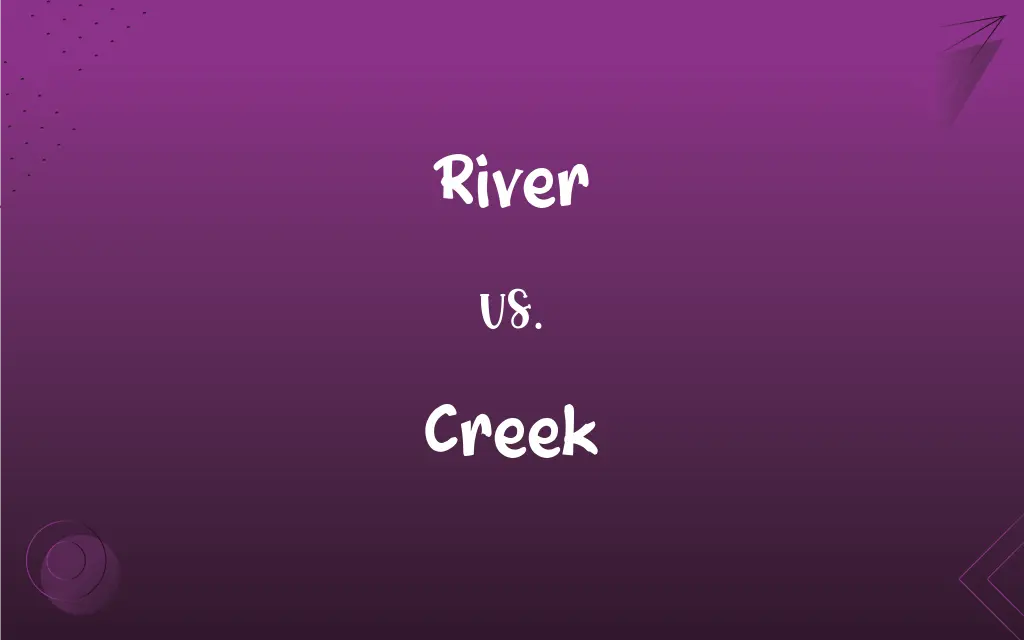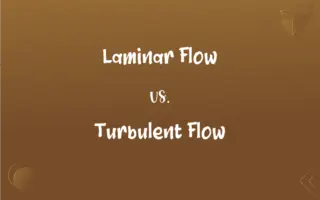River vs. Creek: What's the Difference?
Edited by Aimie Carlson || By Harlon Moss || Updated on June 7, 2024
A river is typically a large, flowing water body, while a creek is smaller, often a tributary to a river or lake, and may dry up in certain seasons.

Key Differences
River and creek are terms that describe water bodies and are essential components in the geographical and ecological systems of the Earth. A river is generally recognized as a large, natural flowing watercourse, usually freshwater, flowing towards an ocean, sea, lake or another river. In contrast, a creek is smaller, often meandering through different terrains, and may not always reach larger water bodies.
One distinct feature that often sets a river apart from a creek is its size and water volume. Rivers tend to be larger and are significant sources of water, proving critical for agricultural and urban needs. Creeks, conversely, are smaller in both aspects, and while they are important, they typically don't bear the same weight of reliance as rivers do in supporting large ecosystems and human activities.
The terminology for river and creek can, however, be a bit fluid and can be influenced by regional vernacular. In some places, what one group might refer to as a river, others might call a creek, and vice versa. Notably, creeks might dry up or significantly reduce in volume in dry seasons, whereas rivers typically are consistent and perennial in their flow.
Ecosystem diversity is another area where rivers and creeks diverge. The extensive size of a river often supports a wider array of wildlife and plant species, due to the varied habitats available along its course. A creek, being smaller, might not host as varied an ecosystem, but still plays a vital role in supporting biodiversity, particularly in dryer landscapes.
While both rivers and creeks are pivotal for the environments they traverse, their geographical, ecological, and social impacts can be notably different. Both are cherished resources, vital for the organisms that rely on them, providing water, transportation, and in many cases, shaping the landscapes through which they flow.
ADVERTISEMENT
Comparison Chart
Size & Volume
Typically larger and voluminous
Smaller and less voluminous
Ecological Impact
Supports larger, varied ecosystems
Supports smaller ecosystems
Dependency
Often crucial for human civilization
Less relied upon for resources
Seasonal Variability
Generally perennial, flows all year
May dry up or reduce in seasons
Terminology Usage
Commonly universal in usage
Can be regionally specific
ADVERTISEMENT
River and Creek Definitions
River
Natural Watercourse.
The Nile River flows through eleven countries in northeastern Africa.
Creek
Tributary.
Often, a creek feeds into larger bodies of water, contributing to their volume.
River
Large Size.
The Amazon River is the second longest in the world, fostering diverse ecosystems.
Creek
Small Watercourse.
The creek meanders gently through the small village.
River
Geographical Boundary.
The Danube River forms part of the border between Romania and Bulgaria.
Creek
Seasonal Flow.
Unlike rivers, some creeks dry up in the summer, affecting local ecosystems.
River
Freshwater Source.
Many cities, like Cairo, depend on a river, the Nile, for their water supply.
Creek
Recreational Spot.
The children spent the afternoon exploring and playing by the creek.
River
Navigation and Transport.
The Mississippi River has historically been a crucial transport route.
Creek
Localized Ecosystem.
Despite its size, the creek supports a unique, localized ecosystem.
River
Abbr. R. A large natural stream of water emptying into an ocean, lake, or other body of water and usually fed along its course by converging tributaries.
Creek
A member of a Native American people formerly inhabiting eastern Alabama, southwest Georgia, and northwest Florida and now located in central Oklahoma and southern Alabama. The Creek were removed to Indian Territory in the 1830s.
River
A stream or abundant flow
A river of tears.
Creek
The Muskogean language of the Creek.
River
The fifth and last of the community cards in various poker games, especially Texas hold'em.
Creek
A Native American confederacy made up of the Creek and various smaller southeast tribes.
FAQs
Do both rivers and creeks support fish life?
Yes, both can support fish, though the species may vary due to size and water quality.
Is the size the only factor differentiating a river from a creek?
Primarily, yes, but usage can be influenced by regional vernacular.
Do rivers and creeks always contain freshwater?
Typically, yes, but some rivers, especially those that are estuarine, might be brackish.
Do rivers always flow into the sea?
Most rivers do, but some flow into lakes, other rivers, or may even end in deserts.
What kind of ecosystems can rivers and creeks support?
Rivers typically support large and diverse ecosystems due to their size, while creeks nurture more localized and potentially specialized ecosystems.
Are there legal regulations protecting rivers and creeks?
Yes, many countries and regions have specific legal frameworks aimed at protecting the ecological integrity of both rivers and creeks.
Can a creek flow into a river?
Yes, creeks often serve as tributaries to larger rivers.
Are rivers always navigable?
Not always. The navigability of a river can depend on its size, depth, and other geographical factors.
Are all rivers part of larger watersheds?
Yes, rivers are often key components of larger watershed systems, contributing to regional hydrological cycles.
Can a river be formed by the confluence of several creeks?
Yes, rivers can be formed by the coming together of several creeks, accumulating in volume to create a larger watercourse.
Can both rivers and creeks dry up?
Yes, both rivers and creeks can dry up or significantly reduce in flow during droughts or dry seasons, though creeks are often more susceptible.
Are creeks important for ecosystems?
Absolutely, creeks play vital roles in local ecosystems and biodiversity.
Can the terms "river" and "creek" be used interchangeably?
In some regional dialects, yes, but generally, they are differentiated by size and volume.
Can human activities affect the health of rivers and creeks?
Absolutely, pollution, dam construction, and other activities can significantly impact both rivers and creeks, affecting their health and the ecosystems they support.
How do creeks contribute to groundwater replenishment?
Creeks can contribute to groundwater replenishment through the process of infiltration, where water percolates down through the soil and recharges underground aquifers.
Is fishing typically allowed in rivers and creeks?
Fishing regulations can vary widely, but fishing is commonly practiced in both rivers and creeks, subject to local laws and seasonal restrictions.
Can rivers and creeks originate from springs?
Yes, both can originate from springs, though rivers often have multiple sources.
Can creeks be found in cities?
Yes, creeks can be found in urban areas and often contribute to urban ecosystems.
Is it common to find creeks in mountainous regions?
Yes, creeks are common in mountainous regions, often formed from melting snow and rainfall.
How does the vegetation differ between rivers and creeks?
Rivers can support a wide range of vegetation due to varied habitats along their course, while creeks might have more limited or specialized vegetation due to their smaller size.
About Author
Written by
Harlon MossHarlon is a seasoned quality moderator and accomplished content writer for Difference Wiki. An alumnus of the prestigious University of California, he earned his degree in Computer Science. Leveraging his academic background, Harlon brings a meticulous and informed perspective to his work, ensuring content accuracy and excellence.
Edited by
Aimie CarlsonAimie Carlson, holding a master's degree in English literature, is a fervent English language enthusiast. She lends her writing talents to Difference Wiki, a prominent website that specializes in comparisons, offering readers insightful analyses that both captivate and inform.































































